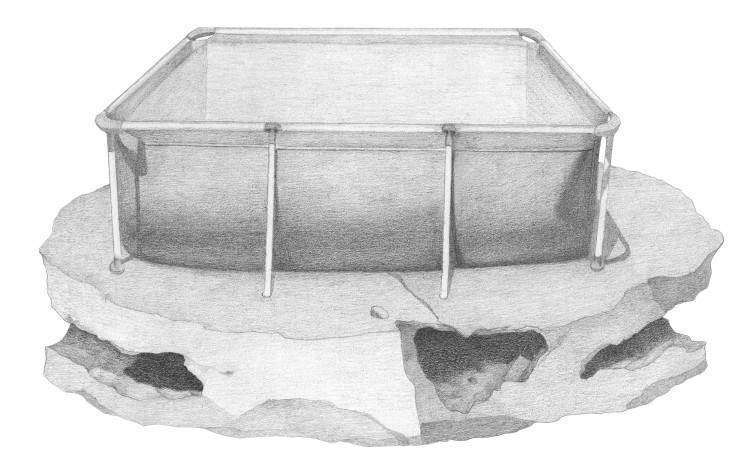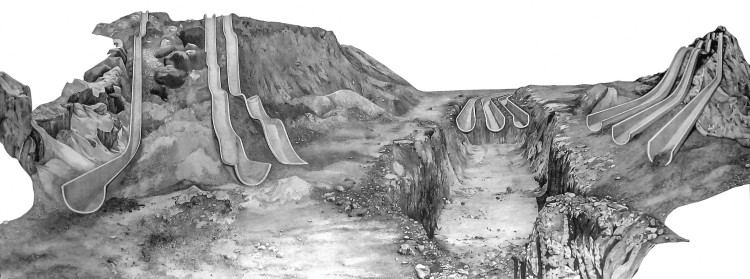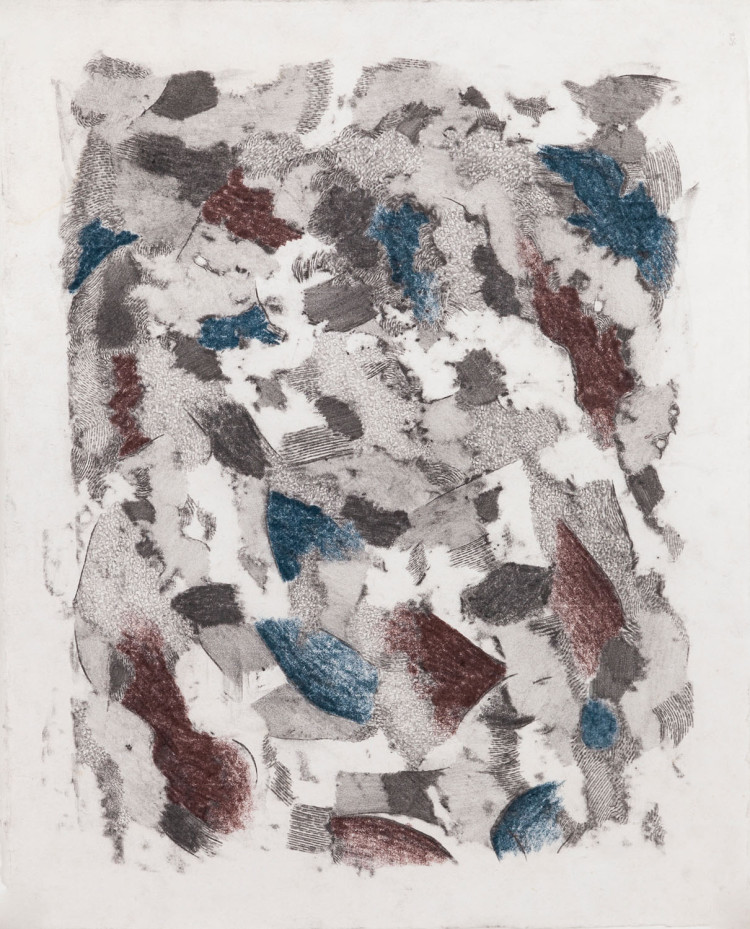Hamlet points to the sky and turns to Polonius. “Do you see yonder cloud that’s almost in the shape of a camel?” Polonius, who has come in the service of the court to persuade the errant young man to visit his mother, the queen—follows the prince’s gaze. “By th’ mass, and ’tis like a camel indeed”, he answers obligingly. But Hamlet is unsatisfied, and draws the courtier further into his sky-gazing reverie. “Methinks it is backed like a weasel”, he counters. “It is backed like a weasel”, comes the somewhat impatient reply. But the prince isn’t through yet: “Or like a whale”, he persists. He is really testing the limits now, but the unimaginative, decidedly practical Polonius has no way of extricating himself from the banter; his courtly role forces him to be perennially agreeable: “Very like a whale”, is the only reply he can meekly proffer. Just when it seems the prince could play puppet master with the foolish old servant for as long as he likes, he abruptly ends the game: “Then I will come to my mother by and by”.
What is taking place during this brief interlude? Is Hamlet truly invested in this idle whimsy? Is he delaying the inevitable responsibility for avenging his father’s death with a few moments of childlike daydreaming? Is this one of the first indications that he is descending into genuine madness? Or is he simply stringing Polonius along, distracting him from his intended task? Perhaps, in this moment, Hamlet understands that the ability to free associate, to call to consciousness things that aren’t there, to interpret and interpolate one’s own perspective into the crude material of everyday life, is a way of retaining his humanity within the sinister chaos of the court. It is in these seemingly whimsical moments that the seeds of his later actions —both tragic and noble— are planted.
In the drawings of Mariana Sissia, the raw material of graphite and paper are used to explore the nature of thinking and acting. While the process of thinking tends to be understood as always and only internal, separate from action that takes place in the world, Sissia uses the drawn mark to merge a psychological experience with a physical one. Like Hamlet, she brings a new reality into being. And, like those of Hamlet, her visions are fleeting and personal, and they escape interpretation: their effect is cumulative, rather than linear. They do not resolve into narrative so much as they evoke dozens of narratives, natural and historical, aesthetic and social. Sissia calls them “Mental Landscapes”, suggesting that the mind is as rich a territory as any tangible one, and inviting the question: where does a map of the mind lead us?
LANDSCAPES
Sissia has described her process as a kind of introspective detective work, in which she reveals the inner workings of her mind through the meditative use of frottage on paper. These rubbings, by their very nature simultaneously controlled and freeform, evoke an incredible array of thoughts and images. As the artist told me:
I don’t have a plan before I start or, rather, the plan is not to have a plan ... to let [the drawing] take shape through the trace that the frottage leaves on the paper. On the basis of intuition, I decide which surface on which to rub the paper, the exact location on which to do the frottage, the blank spaces to be left, and how to interpret it. I conceive as a “script” that takes shape at random, one that I interpret according to my emotional state.
Yet for all the introspection and delicate meditation of these drawings, Sissia also evokes the astonishing variety of the natural world. Blooming flowers, volcanic eruptions, wet rocks in a stream, conifers fluorishing on a mountain’s face —the spread and expansion of these natural textures form a kind of unresolved landscape that floats transiently through the viewer’s consciousness. This thoughtful attention to landscape as mental space shouldn’t be surprising, since two of Sissia’s often-named influences are the Romantic painters Caspar David Friedrich and J. M. W. Turner, who both imbued pictorial representations of landscape with complex psychological resonance. Sissia shares their approach to the sublime, which suffuses the beautiful with an overwhelming sense of awe. She employs variously repeating elements that transform without pause from the delicately decorative —flowery shapes patterned on wallpaper— to the voraciously unyielding, as volcanic ash washes over the ground, subsuming everything in its path.
The relationship between surface and ground in these works is complicated by Sissia’s manipulations of the paper, which is built up with crabbed pencil lines that recall the knobbly trunks of trees, while in other places rubbed smooth like a pebble in the sea. When a gap in the drawing appears —the pencil thinning out to reveal the paper substrate— is the viewer descending into a formless abyss, or is it only the sun breaking through a cloudy sky? We imagine we can press our face against the soft fur of an animal that seems to appear in one densely layered thatch of lines, when the next moment this comfort falls away, to be replaced by the dizzying vertigo of a high aerial perspective. The environment is totalizing, and we cannot tell whether we are looking at a surface in front of us, as with a wall, or from above, as with a sweeping bird’s eye view. As the scales shift and worlds large and small rise and fall before our eyes on the paper, the artist complicates our notion of the line between the active experience of being in the world, and the aesthetic experience that takes place for the viewer of drawing.
Sissia’s technique suggests an introspective response to the Action painters of the mid-twentieth century, who emphasized the relationship between the physical process of making the work, and its physical presence in its finished form. Like Sissia, these painters sought ways to surround themselves with their work during its making. Yet in contrast to the extreme drama of certain gestural abstraction, her work is human scale. Again, the active and meditative converge in the drawings: Sissia has said she sees each drawing as “the mantra I repeat in order to reach a certain state. When my breathing has quieted and my mind goes blank, the drawing takes shape and expands like an organic substance.”
Even as we explore this complex environment with an intrepid sense of adventure, we are drawn into a more psychological reading of the landscape as well. Delicate fingers seem to have left their prints in a thousand places over the surface of each drawing, but how do we read the evidence they’ve left behind? Likewise, the confluence of shape and texture that occasionally resolves itself into a meticulous, handmade Rorschach test: with a sly hand, Sissia creates confusion between the random associative meaning of the inkblot with the carefully articulated visual significance assigned by an artisan. The raw materials of the world brim over with meaning, cultural, spiritual, and personal: pools of water coalesce into figures, smeared windows seem to suddenly reveal the handprint of Jesus. The surfaces of Sissia’s drawings seem to be the perfect reflection of a hundred forms of significance. Every day, our surroundings seem to ask us: What do you see? What does it tell you? How do you read it? Sissia seems to suggest that in these drawings, such contemplation is shared: she invites us into the stream of her consciousness, made visible by mark and texture. Like Hamlet, we watch the clouds go by, grasping at any meaning they might offer us before they disappear from sight; recognizing that it may all be an apparition produced by an active mind, but is no less significant for that.
MOVEMENT
Recently, Sissia has begun hanging her drawings in the middle of the gallery, allowing them to drape across empty space. As their intricate surfaces become voluminous, their stillness is occasionally disrupted: the drawings sway and bow when a visitor enters the room. While this movement does relate to certain forms of kinetic art, the drawings seem less independent than many of those works, more responsive to human activity. The more crowded a space, the more they move, creating the pleasant illusion that the drawings are social—excited by human presence. The literal movement in the room pleasantly echoes the implied, metaphorical movement of the forms on the page.
As they occupy the space with their twisting and leaning, the drawings’ fragility is revealed as a kind of muscular strength. They remind the viewer of a dancer’s body: the simplest movement can carry extreme power when it combines subtlety with absolute control. As with a skilled performer’s sweeping foot or curving wrist, each drawing seems to call up profound significance from extreme economy of means. Sissia cleverly uses the vacuum-like space of the gallery to remind the visitor that, even in a seemingly void-like space, there is constant activity and motion. A primary way she achieves this is through the boldness of size: her drawings billow and sweep like waves across the gallery. Sissia doesn’t think of this method of installing the work as performance, however; rather, it activates latent qualities in the drawings themselves. The surface of each drawing is such a light and deft exploration of the intersection between void and matter that Sissia’s placement of them in space feels particularly intelligent: they are constituted by air, so air is easily felt to be integral to one’s experience of them.
HISTORY
Because Sissia’s work presents an idiosyncratic and singular vision, it is perhaps no surprise that her influences are eclectic and far-reaching. The depth of her knowledge of Western art history is expressed in ways both rigorous and playful, as evidenced by her references to kinetic art and landscape painting, already mentioned. However, one can situate her drawings within a number of traditions that predate the more circumscribed boundaries of modern art movements, including tapestry, Asian scroll paintings, and cave painting. Each of these has a long and complex history, and Sissia’s engagement with them is an indication of the depth and breadth of her project.
Scroll paintings differ from most Western painting in the way that the viewer encounters them: while the latter are viewed at a distance, the former have historically been encountered close-up, at an individualized pace, as the viewer unrolls the piece him or herself. Often, scroll paintings are not made with the expectation that they will be viewed as a whole; rather, one appreciates them in stages as they are rolled and unrolled. One of the most striking qualities of such works is the elastic- ity of time: the phases of life of a warrior might be represented on a single sheet of parchment, depicting, for example, the young boy at his lessons jostling against his older self in the midst of combat on the battlefield. Sissia plays with this elasticity in her own way, as her abstract forms take shape and disappear, one after another, on an endless stage. Like traditional scroll painters, Sissia places a clear importance on format —the long, narrow sheets of thin, translucent paper— that is absent from Western drawing and painting, in which the rectangle or square is the default for most artists. Her use of rice paper underscores her debt to the scroll painting form. Sissia responds to this tradition in the making of her work as well: she has said that she starts each day on a new section of her drawing without looking back at her previous efforts, and often does not even view her larger drawings as a whole until the day of the exhibition opening.
Le Corbusier famously called tapestries “nomadic murals,” and for Sissia, who has referred to her own drawings as “conceptual architecture,” the confluence of the concrete and the ephemeral holds an evident appeal. As an ancient art form, tapestries were valued for their ability to depict grand scenes of religious, military or royal significance, while remaining easily portable, as they could be rolled up and transported as needed. Their simple, repetitive forms flirt with the decorative and domestic while conveying myths and history on epic scale.
Indeed, as Sissia’s rice paper surfaces float in the breeze, one begins to liken them to coats of arms, or delicate, drooping flags. At first their fragility seems to undermine their impressiveness, but then the viewer quickly realizes that all flags are made to move: unlike a stamp or a printed sign, flags gain their power from their visible motion, as they flutter and sway above capital domes or from the masts of ships. No matter how full of life and motion they are, they remain persistently in the realm of representation, never quite becoming “real.” It is this combination that is perhaps most intriguing: Sissia’s images, in their size and scope, demand attention and invite reflection, but they are also grey, blurred and inconclusive, and they raise more questions than they answer. There is a humor in Sissia’s insistence that her quiet, subtle forms be presented as unavoidable, unapologetic, even bombastic. There is something ceremonial about them, and they convey a tentative pride as they festoon the space, lending a sense of simultaneous solemnity and celebration. But what small nation do they represent? In the name of what humble people are these banners raised? Unlike tapestry, in Sissia’s cosmology, myths and histories are more evocative for their lack of specificity. Her work does not actually depict legible narratives, any more than they function as real architecture. If any signs or symbols are present, they should be read in a way akin to constellations, to be regarded with the same combination of significance and mystery which humans have sought and found in the stars for thousands of years.
Finally, Sissia’s drawings call to mind the most ancient drawings we know of—those found in caves dating from prehistoric times. One can easily imagine a horse or elk or spear-wielding hunter taking shape out of the grey tangle of graphite contours and furrows. It is thought that cave painting was a ritualistic practice: hunters depicted animals in order to conjure a more successful future hunt, while shamans adorned cave walls in the hopes of drawing out their power. Sissia’s meditative technique echoes this sense of drawing as spiritual. Her drawings also recall the strange placelessness of cave art: on the dark walls, animals and symbols float in a groundless space, detached from any sense of time or location. Imagining Sissia’s drawing on a wall in Lascaux, though, the viewer would find it difficult to say where the drawing ends and the stone surface of the cave begins. Imagined inside a cave, the blemishes on the wall would become part of the image; the patterns on each animal’s skin would blend with erosions and patches of dirt. The scrapes and abrasions in the paper caused by Sissia’s frottage technique even, in places, call to mind the direct intervention, the scratching or clawing, of living creatures. Every mark is also a rubbing, an incising, into the page; surface and substrate are inextricably linked. Like an archeologist, Sissia is excavating as much as she is drawing.
Why does Sissia draw? This most basic of questions leads to perhaps the most provocative exploration of the significance behind her work. Though many of her influences are to be found in painting, she emphatically grounds her work in the medium of drawing. What compels, again and again, her use of the pencil in so many permutations? Drawing is of- ten described as a kind of thinking: it is raw and direct, relatively unmediated in its relation between marking tool and substrate. Indeed, Sissia has said she does not use color in her drawings because she feels it will get in the way of the pure sense of gesture she is attempting to convey. The history of drawing is that of exploration and observation: drawings are used to articulate what the draftsman sees. The drafstman is an inventor whose every decision is visible in the final product, as a form of visual thinking, existing in the present tense, and always full of the potential for further embellishment. Sissia frustrates this expectation: her use of frottage is both evidence of her hand and its effacement; the technique creates a tension between the presence and absence of the artist.
Drawing is an intellectual pursuit, even a philosophical one; early theories of drawing invoked Plato’s notion of the representation of the ideal in nature. Sissia’s earlier landscape drawings were much more literal in term of this relationship: she would observe the view that interested her, and then attempt to reproduce it. Today, her drawings exploit the mimetic tradition by blurring the line between what she perceives and what she feels. She challenges the notion of precision in terms of observation: the lines in her work seem to create the boundaries not of distinct and identifiable shapes, but of blurs, smudges, and ambiguous forms. Drawing also allows an artist to build an image slowly. In Sissia’s case, individual marks accumulate to produce a paradoxically vast and cohesive landscape of gesture and tone. Her lines often seem to be following some path that the viewer cannot quite discern. While drawing has traditionally been understood as the ultimate medium of mimesis, she suggests that it might be used to undermine the very idea that nature is directly observable at all. Rather, there is a symbiotic relation- ship between the observer and the observed. Sissia’s drawings evoke the fact that experience is both something you enact, and something that happens to you. Life, as it is lived, leaves its mark on you.


















































































































































































